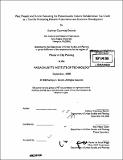| dc.contributor.advisor | Ezra Haber Glenn. | en_US |
| dc.contributor.author | Emmitt, Kathryn Courtney | en_US |
| dc.contributor.other | Massachusetts Institute of Technology. Dept. of Urban Studies and Planning. | en_US |
| dc.coverage.spatial | n-us-ma | en_US |
| dc.date.accessioned | 2009-04-29T17:32:04Z | |
| dc.date.available | 2009-04-29T17:32:04Z | |
| dc.date.copyright | 2008 | en_US |
| dc.date.issued | 2008 | en_US |
| dc.identifier.uri | http://hdl.handle.net/1721.1/45371 | |
| dc.description | Thesis (M.C.P.)--Massachusetts Institute of Technology, Dept. of Urban Studies and Planning, 2008. | en_US |
| dc.description | Includes bibliographical references (p. 99-100). | en_US |
| dc.description.abstract | The first half of the 20th century saw very little interest in the preservation of historic properties; indeed, much of the nation's historic building stock was at risk of being lost forever, as the pressures of mid-century urban renewal threatened the historic city center, while historic buildings in suburban and rural communities across America were seen as outmoded, expendable, and too expensive to maintain. The creation of the Federal Historic Preservation Tax Incentive in 1976 did much to change this dire situation, breathing new life into our nation's aging built heritage, making preservation an attractive and profitable option for developers and government alike. During the thirty-plus years since it was put into action, the Federal Historic Preservation Tax Credit, along with analogous rehabilitation tax credit programs at the state level, have played a significant role in saving thousands of historic buildings by providing an appealing incentive to do so. In 2003, the Massachusetts legislature signed into law its own such program, the Massachusetts Historic Rehabilitation Tax Credit (MAHRTC). With its stated goals to promote historic preservation and economic development in the Commonwealth, the MAHRTC provides an income tax credit equal to up to 20% of eligible costs of approved rehabilitation to income-producing properties. Since its introduction four years ago, the program has already received a lot of attention, but has yet to undergo the careful review that it deserves. | en_US |
| dc.description.abstract | (cont.) This thesis puts the MAHRTC under the proverbial microscope, revealing its plus points as well as its flaws; it provides an in-depth analysis of the MAHRTC as policy, including an examination of its procedural administration, and the decision making processes behind the program's initial development and subsequent evolution; it evaluates the MAHRTC's ability to increase preservation activity in the Commonwealth; and finally, the thesis proposes recommendations to enhance the program's capacity to attain its stated goals. | en_US |
| dc.description.statementofresponsibility | by Kathryn Courtney Emmitt. | en_US |
| dc.format.extent | 100 p. | en_US |
| dc.language.iso | eng | en_US |
| dc.publisher | Massachusetts Institute of Technology | en_US |
| dc.rights | M.I.T. theses are protected by
copyright. They may be viewed from this source for any purpose, but
reproduction or distribution in any format is prohibited without written
permission. See provided URL for inquiries about permission. | en_US |
| dc.rights.uri | http://dspace.mit.edu/handle/1721.1/7582 | en_US |
| dc.subject | Urban Studies and Planning. | en_US |
| dc.title | Past, present and future : evaluating the Massachusetts Historic Rehabilitation Tax Credit as a tool for promoting historic preservation and economic development | en_US |
| dc.title.alternative | Evaluating the MAHRTC as a tool for promoting historic preservation and economic development | en_US |
| dc.type | Thesis | en_US |
| dc.description.degree | M.C.P. | en_US |
| dc.contributor.department | Massachusetts Institute of Technology. Department of Urban Studies and Planning | |
| dc.identifier.oclc | 317134544 | en_US |
